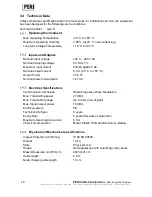
PERI InSite Construction -
Data Acquisition System
Instructions for Installation and Use - Technical Cabinet with Main Unit and Nodes – Preliminary Draft –
29
Installation of Nodes type N-TRF and N-TE
4.1.2.1 General preparation
Selecting suitable installation positions
It is recommended to define and document suitable installation positions in advance. The
Nodes should be positioned close to the points of measurement and within the radio range of
the Main Unit. If possible, the Nodes should be protected from unnecessary exposure of wind,
rain and sun. A plastic bag over the Node after it has been installed will not affect the radio
range but will prolong the overall lifetime of the Node. Excessive sun and rapid temperature
changes can affect the accuracy of the measurement.
Select a node and carry it to the location
Detach the Node from the charging bay and visually inspect it looking for any damages to the
antenna, connectors or keyboard. Turn the Node on and make sure it establishes a connection
with the Main Unit. Also make sure that the node has enough battery to last for the duration of
the foreseeable measurement period. While a node can run for quite a few days with a
BATTERY STATUS
indicating
WEAK
it is recommended to have at least half the battery
capacity left indicated by at least two lit LED indicator lamps when the
BATTERY STATUS
is
pushed. See chapter 3.7.1 for a more detailed description on how the Node user interface
works.
If the Node battery is too weak, select another node from the charging bay and make
sure that it is connected to the Technical Cabinet.
Carry the Node to the location where it should be installed. Push the
SIGNAL QUALITY
button
and ensure the signal quality is at least
WEAK
as indicated by the lit LED indicator lamps. A
flashing LED lamp under the
WEAK
headline means that the Node is too far away from the
Main Unit - reconsider the installation location or move the Main Unit closer. Alternatively place
a repeater node between the Node with the weak signal and the Main Unit.
Make careful notes of exactly where the Node was placed. Finding a Node on an ever-
changing construction site can be very difficult without proper documentation.
4.1.2.2 Installation of Node type N-TRF
Ambient climate - Selecting suitable installation positions
The N-TRF Node measures the temperature and humidity in the air surrounding its sensor
probe. It is recommended to place it shielded from rain. Extremely wet conditions will moisten
up the sensor probe and possibly damage it.
Good locations outdoors are under a roof or other horizontal surface that shields the Node
from wind, rain and direct sunshine. Indoors the Node should be placed around one meter
above the floor. Placing the Node directly on a newly cast concrete slab will measure the humid
climate directly above the surface which could lead to an over estimation of the air humidity in
the room.
Ambient climate - Select a node and carry it to the location
The initial installation procedure is identical with the procedure described in section 4.1.2.2.2
for the Node type N-TE. Follow the instructions in the aforementioned section to finish the
installation.
















































